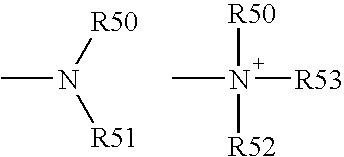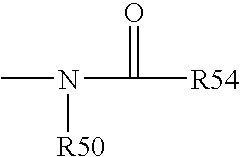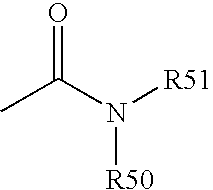Cyclopamine analogues and methods of use thereof
a technology of cyclopamine and analogues, applied in the field of cyclopamine analogues, can solve problems such as cell death, and achieve the effects of preventing or slowing unwanted cell proliferation, smo-dependent pathway activation, and reducing the risk of cell death
- Summary
- Abstract
- Description
- Claims
- Application Information
AI Technical Summary
Benefits of technology
Problems solved by technology
Method used
Image
Examples
example 1
Preparation of a Derivative of Cyclopamine
[0292]
[0293]
[0294]To a solution of cyclopamine 2 (250 mg, 0.6 mmol, 1 eq) in DCM (10 mL) at rt was added Fmoc-OSu (205 mg, 0.6 mmol, 1 eq) and the resulting mixture was stirred at rt overnight. The resulting solution of crude Fmoc-cyclopamine was then cooled to 0° C. and was treated with 15% diethylzinc in toluene (0.5 mL, 0.6 mmol, 1 eq) and stirred for 30 min (Flask A).
[0295]Diiodomethane (0.4 mL, 6 mmol, 10 eq) in DCM (20 mL) at 0° C. was treated with 15% diethylzinc in toluene (3 mL, 3 mmol, 5 eq) and the resulting solution was stirred for 5 min (Flask B).
[0296]The contents of Flask B were transferred to Flask A via cannula and the resulting suspension was stirred for 5 h at rt. The reaction was quenched with HCl (1 M), stirred for 10 min (until all white solid redissolved) and extracted with DCM (5×). The organic extracts were dried (MgSO4), filtered over Celite and concentrated in vacuo. The residue was purified by flash chromatography...
example 2
Preparation of a Derivative of Cyclopamine
[0299]
[0300]
[0301]To a solution of hydrocinnamic acid 5 (3.01 g, 20 mmol, 1 eq) in anhydrous chloroform (30 mL) at 75° C. was added thionyl chloride (1.75 mL, 24.1 mmol, 1.2 eq) dropwise over a period of 3 min. The mixture was refluxed for 3.5 h. The solvent was distilled off to give the crude acid chloride as a light yellow viscous liquid. The crude was used without further purification.
[0302]
[0303]To a biphasic mixture of 7 (3.16 g, 24.1 mmol, 1.2 eq) in DCM (30 mL) and an aqueous solution of NaOH (2.0 M, 30 mL, 3 eq) at 25° C. was added a solution of the acid chloride 6 (3.38 g, 20 mmol, 1 eq) in DCM (10 mL) and the resulting mixture was stirred at 25° C. for 3 h. The mixture was then neutralized with aqueous HCl (2 M, 30 mL). The organic layer was then separated and the aqueous layer was extracted with DCM (3×50 mL). The combined organic layers were washed with HCl (2.0 M, 25 mL), water (3×50 mL), saturated brine (50 mL), dried over magn...
example 3
Preparation of a Derivative of Cyclopamine
[0310]
[0311]
[0312]Cyclopamine 2 (20 mg, 0.049 mmol, 1 eq) was suspended in dry toluene (0.6 mL) and cyclohexanone (150 μL, 1.47 mmol, 30 eq) followed by aluminum isopropoxide (79 mg, 0.392 mmol, 8 eq) were added. The resulting mixture was heated to reflux for 2 h, cooled to rt, diluted with AcOEt and quenched with Rochelle's salt solution. The biphasic mixture was stirred overnight, the layers were separated, the aqueous extracted with AcOEt and the combined organic extracts dried (MgSO4), filtered and concentrated in vacuo. The residue was purified by flash chromatography (DCM, DCM / MeOH 98:2 and 95:5). The target was obtained as a white crystalline solid (70% yield).
[0313]
[0314]Diiodomethane (40 μL, 0.5 mmol, 25 eq) in DCM (0.52 mL) at 0° C. was treated with 15% diethylzinc in toluene (0.2 mL, 0.2 mmol, 10 eq) and the resulting solution was stirred for 5 min. Compound 12 (10 mg, 0.02 mmol, 1 eq) in DCM (0.35 mL) was added and the resulting ...
PUM
| Property | Measurement | Unit |
|---|---|---|
| pH | aaaaa | aaaaa |
| pH | aaaaa | aaaaa |
| pH | aaaaa | aaaaa |
Abstract
Description
Claims
Application Information
 Login to View More
Login to View More - R&D
- Intellectual Property
- Life Sciences
- Materials
- Tech Scout
- Unparalleled Data Quality
- Higher Quality Content
- 60% Fewer Hallucinations
Browse by: Latest US Patents, China's latest patents, Technical Efficacy Thesaurus, Application Domain, Technology Topic, Popular Technical Reports.
© 2025 PatSnap. All rights reserved.Legal|Privacy policy|Modern Slavery Act Transparency Statement|Sitemap|About US| Contact US: help@patsnap.com



